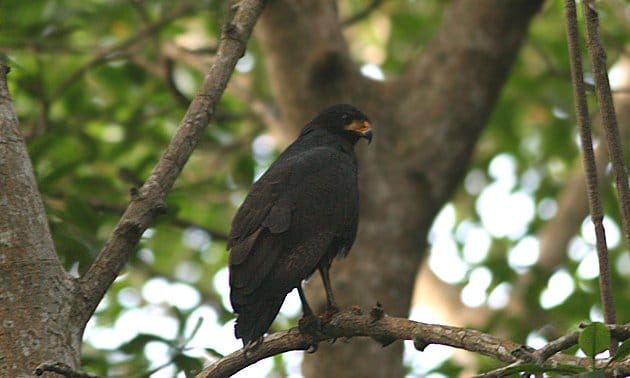This unhappy-looking tar baby is covered with a green, environmentally-friendly product called Tanglefoot.
It is a non-drying, sticky compound that is used to protect trees by forming a barrier against climbing insects. Normally it might not be a problem, but last October a farmer in upstate New York spread it on an  apple tree so thickly that the product slid down the branches and pooled in the tree’s crotch. This little Eastern Screech-Owl arrived sometime thereafter, and, no doubt, has regretted it every day for the last six months.
apple tree so thickly that the product slid down the branches and pooled in the tree’s crotch. This little Eastern Screech-Owl arrived sometime thereafter, and, no doubt, has regretted it every day for the last six months.
A woman walking her dog discovered the owl and alerted the farmer, who called a local wildlife hotline. To his credit, the farmer was distraught and offered to pay any vet bills which might ensue, and has since learned how to paint his trees with a lighter hand. There were no actual vet bills to pay, as the two vets consulted donated their time; but in terms of time and labor spent, this is a million-dollar owl.
At first Lisa Acton, the New York rehabilitator who took the owl in, thought he was dead. She gave him subcutaneous fluids, warmed him up, and when he was feeling a bit better, figured she could clean him with Dawn dishwashing liquid, the rehabber’s tried and true method of getting oily stuff off birds. That didn’t work, though, because the product was sticky as well, so she tried another rehabber trick: the cream filling of Hostess Twinkies. (I’m not making this up. The cream contains polysorbate 60, which usually dissolves sticky gunk from bird feathers.
Unfortunately, no dice. Lisa looked up Tanglefoot’s ingredients, and found that it contained gum resins, vegetable wax and castor oil, the combination of which seemed to defy removal. She called Contech Enterprises, the Canadian parent company of Tanglefoot, but she was passed from employee to employee until she hung up in frustration. She hit the telephone and the internet, and before long she had two veterinarians and a dozen rehabbers in several states trying to help her. Since the owl was in no condition to be a test case, the wildlife lovers all rushed out to hardware stores to buy tubes of Tanglefoot and various oils, lotions, and removal creams; they then took molted feathers, which rehabbers and bird vets always have lying around on their counters, covered them with Tanglefoot, then proceeded to try to remove it by using various combinations.
Meanwhile, Lisa had covered the owl in cornstarch, which at least soaked up some of the mess,  and was monitoring him carefully. Lethargic at first, he responded to her care with such fighting spirit that she dismissed all suggestions that she put him down. Lisa has fighting spirit-overload herself; she responded to questions about her decision by snapping, “Hey! If you ever fall in tar, should I put YOU down?”
and was monitoring him carefully. Lethargic at first, he responded to her care with such fighting spirit that she dismissed all suggestions that she put him down. Lisa has fighting spirit-overload herself; she responded to questions about her decision by snapping, “Hey! If you ever fall in tar, should I put YOU down?”
Thirty hours later, Lisa’s husband Joe came up with the solution: Permatex DL Organic Mechanic Soap. So began a daily regimen, created by a network of veterinarians and bird rehabbers: each morning the owl was bathed in Dawn dishwashing liquid, followed by a cornstarch powdering; then each evening, Mechanic Soap would be carefully worked through his feathers, followed by a rinse with King’s Cages’ Feather Shine Shampoo. This lasted for two weeks.
Once the Tanglefoot was gone, what remained was to keep the owl warm, since his feathers had taken such a beating he no longer had the ability to thermoregulate. He spent the winter at Lisa’s and earned the name Godzilla, though no one blamed him for his attitude.
Now that spring is here, he needs to molt and get rid of his ratty feathers, some of which he has overpreened, probably due to boredom. Lisa is trying a falconer’s trick of exposing him to UV light 12 hours per day, sort of like forcing bulbs, but with light and heat instead of dark and cold. If all goes well, he will soon have a beautiful, shiny new set of feathers, and a substantial crowd to watch him return to the wild. Whether or not he ever lands in a tree again is anyone’s guess.





 New writers welcome – please contact us for details.
New writers welcome – please contact us for details.

















That is such an amazing story! Lisa sounds like a pretty awesome person, and so are all those people who were working to figure out a solution. And who was it that discovered that Twinkie cream is a solution for sticky stuff?!?! I hope the owl recovers well. I’d love to hear an update. Thanks for sharing, Suzie!
This is such an incredible story, and a poignant illustration of how so many products, even seemingly safe ones, present unintended hazards to wildlife. Some of the bird entanglements brought into our wildlife hospital involved products most people wouldn’t associate with lethal effects. I give Lisa so much credit for pursuing a solution with such diligence and compassion for this owl. What an exceptional person and what a beautiful retelling by Suzie.
Tanglefoot is also used as a “harmless”, “safe” method of deterring pigeons, starlings, and other birds from perching and nesting in unwanted areas. We have had to deal with a number of birds that were coated with it. All were hypothermic or hyperthermic depending on the day and all were emaciated. We had a terrible time getting rid of the stuff too!
Hey Maureen, if you click on the green type after the Twinkie description, you’ll get the whole story! And I hope to update you soon. Thanks, Ingrid, there were so many people involved in this owl’s treatment, but Lisa sure did all the actual care. And Nancy, thanks for bringing up the fact that Tanglefoot is used as a bird repellent, too – it’s definitely not a safe product….
Thanks everyone. Godzilla is so far responding well to the UV treatments.
thanks Suzie for telling his story. I will keep you posted on his progress. I
Can,t wait to release him and watch him fly off in the sunset. 🙂
Lisa, you are one lucky lady! 🙂